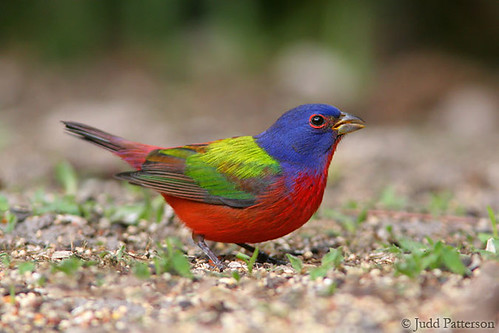
Male Painted Bunting, Passerina ciris.
Image appears here with the kind permission of the photographer, Judd Patterson.
Click image for larger view in its own window.
Birds in Science
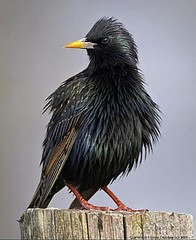 The European starling, Sturnus vulgaris (pictured) -- long known as a virtuoso songbird and expert mimic - may also soon win a reputation as something of a grammatician, researchers say. Timothy Gentner, a psychologist at the University of California, San Diego, and his team found that the bird can learn language patterns formerly thought to be unique to humans. They discovered that starlings can understand recursive center-embedding, is what lets speakers make new sentences by inserting words and clauses within other sentences. [Photographer: Gene Oleynik]
The European starling, Sturnus vulgaris (pictured) -- long known as a virtuoso songbird and expert mimic - may also soon win a reputation as something of a grammatician, researchers say. Timothy Gentner, a psychologist at the University of California, San Diego, and his team found that the bird can learn language patterns formerly thought to be unique to humans. They discovered that starlings can understand recursive center-embedding, is what lets speakers make new sentences by inserting words and clauses within other sentences. [Photographer: Gene Oleynik]
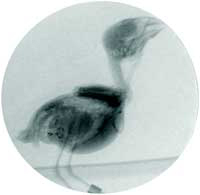 Humans control their speech through movements in their upper vocal tract, but less is known about how birds control their song. However, Tobias Riede and colleagues used x-ray cinematography of male northern cardinals, Cardinalis cardinalis, as they sang notes common in cardinal songs. These cinematography revealed that songbirds adjust their song's tonal qualities by actively changing the shape of their upper vocal tract. "Songbirds, who learn their vocal patterns just as humans do, demonstrate here yet another similarity to humans--that is, in using precise motor control to create complex patterns in the upper vocal tract," says Riede. This research was published in the 27 March issue of the peer-reviewed journal Proceedings of the National Academy of Sciences. Story includes a link to the x-ray movie. [Abstract; image by Tobias Riede and Rod Suthers].
Humans control their speech through movements in their upper vocal tract, but less is known about how birds control their song. However, Tobias Riede and colleagues used x-ray cinematography of male northern cardinals, Cardinalis cardinalis, as they sang notes common in cardinal songs. These cinematography revealed that songbirds adjust their song's tonal qualities by actively changing the shape of their upper vocal tract. "Songbirds, who learn their vocal patterns just as humans do, demonstrate here yet another similarity to humans--that is, in using precise motor control to create complex patterns in the upper vocal tract," says Riede. This research was published in the 27 March issue of the peer-reviewed journal Proceedings of the National Academy of Sciences. Story includes a link to the x-ray movie. [Abstract; image by Tobias Riede and Rod Suthers].
Birds Helping People
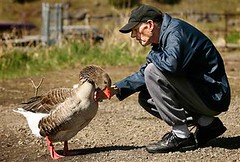 A northern Idaho man diagnosed with terminal cancer says a typically cantankerous goose that befriended him on his walks has helped him live past doctors' predictions. The goose, called Mr. Waddles, is a feral domestic goose, said a biologist with the Idaho Department of Fish and Game, offering no explanation for the relationship that has developed between the goose and Bill Lytle, a former two-time state legislator.
A northern Idaho man diagnosed with terminal cancer says a typically cantankerous goose that befriended him on his walks has helped him live past doctors' predictions. The goose, called Mr. Waddles, is a feral domestic goose, said a biologist with the Idaho Department of Fish and Game, offering no explanation for the relationship that has developed between the goose and Bill Lytle, a former two-time state legislator.
People Helping Birds
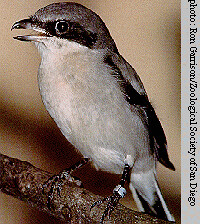 When conservation biologist Tom Scott started investigating the plight of the San Clemente loggerhead shrike, Lanius ludovicianus mearnsi (pictured), in the late 1970s, he spent his days hiking and his nights camping on the rocky outcropping in the Pacific Ocean. What he discovered as a doctoral student was startling: The sharp-beaked shrikes were so close to extinction they eventually would be billed as North America's most endangered bird. These birds are endangered by the effects of habitat destruction by introduced goats, predation by foxes and by feral cats and introduced rats, and by fires started as the result of the navy's use of the island for target practice. This population of shrikes gained federal protection in 1977. Since 1999, the captive breeding program has released more than 250 birds into the wild, and those birds have produced some 280 juveniles. "(The population) can go higher," said Kelly Brock, the Navy's lead wildlife biologist on San Clemente. "We don't know how much higher - that is one of the challenges we are struggling with. What is the carrying capacity of the island?" [Photographer: Ron Garrison, SDZ].
When conservation biologist Tom Scott started investigating the plight of the San Clemente loggerhead shrike, Lanius ludovicianus mearnsi (pictured), in the late 1970s, he spent his days hiking and his nights camping on the rocky outcropping in the Pacific Ocean. What he discovered as a doctoral student was startling: The sharp-beaked shrikes were so close to extinction they eventually would be billed as North America's most endangered bird. These birds are endangered by the effects of habitat destruction by introduced goats, predation by foxes and by feral cats and introduced rats, and by fires started as the result of the navy's use of the island for target practice. This population of shrikes gained federal protection in 1977. Since 1999, the captive breeding program has released more than 250 birds into the wild, and those birds have produced some 280 juveniles. "(The population) can go higher," said Kelly Brock, the Navy's lead wildlife biologist on San Clemente. "We don't know how much higher - that is one of the challenges we are struggling with. What is the carrying capacity of the island?" [Photographer: Ron Garrison, SDZ].
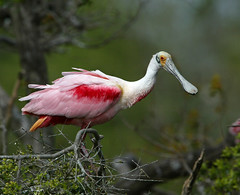 Endangered roseate spoonbills, Platalea ajaja (pictured), are an important "indicator species" in the everglades. Because they are so sensitive to environmental changes, a thriving spoonbill population means the ecosystem is healthy for other wildlife. Roseate spoonbills were hunted to virtual extinction in the Tampa Bay area in the 1880s. The birds were killed for their meat and colorful feathers. In 1975, seven pairs returned to the area. The local spoonbill population has grown to about 360 nesting pairs. "We're very pleased with the attention people are giving this project," said Ann Paul, regional coordinator for the Florida Coastal Island Sanctuaries in Tampa Bay. "We think there's going to be a real payoff. The more we learn, the more we can sustain the spoonbills' future." [Photographer: John Kormendy]
Endangered roseate spoonbills, Platalea ajaja (pictured), are an important "indicator species" in the everglades. Because they are so sensitive to environmental changes, a thriving spoonbill population means the ecosystem is healthy for other wildlife. Roseate spoonbills were hunted to virtual extinction in the Tampa Bay area in the 1880s. The birds were killed for their meat and colorful feathers. In 1975, seven pairs returned to the area. The local spoonbill population has grown to about 360 nesting pairs. "We're very pleased with the attention people are giving this project," said Ann Paul, regional coordinator for the Florida Coastal Island Sanctuaries in Tampa Bay. "We think there's going to be a real payoff. The more we learn, the more we can sustain the spoonbills' future." [Photographer: John Kormendy]
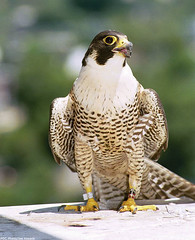 He is one of the oldest peregrine falcons, Falco peregrinus (pictured), in the state of Virginia, a 16-year-old patriarch whom ornithologists have nicknamed James, since he has lived atop the James River Bridge for more than a decade. She is much younger, just 3 or 4 years old, her origins unknown. The spry female showed up at the bridge last fall -- about the same time that James' longtime mate and partner, Virginia, inexplicably disappeared. Virginia has not been seen since. James and his new mate have gotten busy. The four chicks and their mismatched parents highlight what is shaping into a strong year for peregrine falcons in Virginia. Shawn Padgett, a falcon expert from the Center for Conservation Biology, part of the College of William and Mary, said 22 pairs of falcons nested this year, up from 20 last year, mostly in manmade structures east of Interstate 95. They have produced at least 14 offspring so far, though more may hatch later. [Photographer: Joe Kosack]
He is one of the oldest peregrine falcons, Falco peregrinus (pictured), in the state of Virginia, a 16-year-old patriarch whom ornithologists have nicknamed James, since he has lived atop the James River Bridge for more than a decade. She is much younger, just 3 or 4 years old, her origins unknown. The spry female showed up at the bridge last fall -- about the same time that James' longtime mate and partner, Virginia, inexplicably disappeared. Virginia has not been seen since. James and his new mate have gotten busy. The four chicks and their mismatched parents highlight what is shaping into a strong year for peregrine falcons in Virginia. Shawn Padgett, a falcon expert from the Center for Conservation Biology, part of the College of William and Mary, said 22 pairs of falcons nested this year, up from 20 last year, mostly in manmade structures east of Interstate 95. They have produced at least 14 offspring so far, though more may hatch later. [Photographer: Joe Kosack]
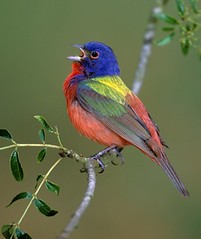 The Painted Bunting Observer Team (PBOT) at the University of North Carolina Wilmington is seeking help from volunteers to support a research study in North and South Carolina to develop strategies to sustain and increase the numbers of these brightly colored migratory birds. Sadly, the Painted Bunting population is declining in the coastal areas of North and South Carolina, said Dr. Jamie Rotenberg, ornithologist at UNCW. Painted Buntings, Passerina ciris (male, pictured, also at top), arrive in the Carolinas usually in April and stay throughout the summer, migrating south during the month of August. "Volunteer Painted Bunting Observer Teams are a crucial part of the study as citizen scientists can help us monitor and collect behavioral data in the field," explained Rotenberg. "Our goal is to have hundreds of PBOTs throughout the Painted Bunting breeding grounds in North and South Carolina." [Photographer: Alan Murphy]
The Painted Bunting Observer Team (PBOT) at the University of North Carolina Wilmington is seeking help from volunteers to support a research study in North and South Carolina to develop strategies to sustain and increase the numbers of these brightly colored migratory birds. Sadly, the Painted Bunting population is declining in the coastal areas of North and South Carolina, said Dr. Jamie Rotenberg, ornithologist at UNCW. Painted Buntings, Passerina ciris (male, pictured, also at top), arrive in the Carolinas usually in April and stay throughout the summer, migrating south during the month of August. "Volunteer Painted Bunting Observer Teams are a crucial part of the study as citizen scientists can help us monitor and collect behavioral data in the field," explained Rotenberg. "Our goal is to have hundreds of PBOTs throughout the Painted Bunting breeding grounds in North and South Carolina." [Photographer: Alan Murphy]
People Hurting Birds
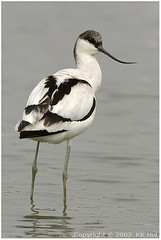 A rare wading bird found dead near Immingham Docks, UK, had almost certainly been shot with an air gun, according to RSPB officials who have condemned the crime. The body of the female avocet, Recurvirostra avosetta (pictured), was found last week and a post mortem has found that a wound through the bird's neck is consistent with it having been hit by a pellet from an airgun. Avocets are protected by UK law and anyone convicted of killing one of the birds is liable to a fine of up to £5,000 or six months in jail, or both. Avocets are a type of wading bird and have an eye-catching black and white plumage and a characteristic upcurved bill. A symbol of conservation success in the UK, the avocet is the emblem of the RSPB. They were extinct in the United Kingdom until after the Second Word War when they colonised East Anglia. They are still a rare bird in the UK with only around 1,300 nesting pairs. [Photographer: K K Hui]
A rare wading bird found dead near Immingham Docks, UK, had almost certainly been shot with an air gun, according to RSPB officials who have condemned the crime. The body of the female avocet, Recurvirostra avosetta (pictured), was found last week and a post mortem has found that a wound through the bird's neck is consistent with it having been hit by a pellet from an airgun. Avocets are protected by UK law and anyone convicted of killing one of the birds is liable to a fine of up to £5,000 or six months in jail, or both. Avocets are a type of wading bird and have an eye-catching black and white plumage and a characteristic upcurved bill. A symbol of conservation success in the UK, the avocet is the emblem of the RSPB. They were extinct in the United Kingdom until after the Second Word War when they colonised East Anglia. They are still a rare bird in the UK with only around 1,300 nesting pairs. [Photographer: K K Hui]
Ivory-billed Woodpecker News
Just as the search for the Ivory-billed woodpecker in Cuba has begun, the hunt has been postponed until autumn in Arkansas. Gene Sparling first reported seeing the elusive ivory-billed woodpecker in the Bayou DeView near Brinkley, Arkansas, more than two years ago, was in the White River National Refuge near St. Charles with a couple of ornithologists, searching for the fabled bird. Critics say Sparling didn't see the ivory-bill but the more common pileated woodpecker. A video shot by David Luneau of the University of Arkansas supposedly shows the rare bird because of the white on top of its wings, but skeptics say the white is really under its wings, which is characteristic of the pileated woodpecker. The Interior Department had previously awarded more than $2 million to help with the search for the ivory-bill. The Nature Conservancy, which has been helping to preserve the habitat for decades, has bought and reforested thousands of acres in the Big Woods, which is home to hundreds of species, including the mallard duck, which will also thrive under the preservation program.
Avian Influenza News
 Many scientists believe much of the worldwide spread of H5N1 is linked to the migration of wild birds, but the Paris-based World Organization for Animal Health says it is investigating the possible role smuggling has played in some countries. For example, in 2005, Taiwan confirmed its 1st case of bird flu, which was found in birds smuggled from China. A Nigerian official also has blamed illegal poultry imports for introducing the virus there earlier this year, though agency spokeswoman Maria Zampaglione said that has not been confirmed. She said the organization is recommending that governments worldwide pay more attention to the illegal trade of poultry but said China is not specifically being looked at as a source. Chinese officials have not responded to queries about whether smuggling has occurred. ''There's lots of illicit movements of livestock products around the world,'' said Dr. Peter Roeder, an animal health expert at the FAO's base in Rome. ''The meat comes in packed in vegetable containers and with other goods and the customs authorities just find it extremely difficult to be on top and inspecting everything.'' He said another worry is the trade of manure-based fertilizers and animal feed, which often contains ground-up poultry parts, from infected countries. FAO is examining what role they could play in the spread of H5N1.
Many scientists believe much of the worldwide spread of H5N1 is linked to the migration of wild birds, but the Paris-based World Organization for Animal Health says it is investigating the possible role smuggling has played in some countries. For example, in 2005, Taiwan confirmed its 1st case of bird flu, which was found in birds smuggled from China. A Nigerian official also has blamed illegal poultry imports for introducing the virus there earlier this year, though agency spokeswoman Maria Zampaglione said that has not been confirmed. She said the organization is recommending that governments worldwide pay more attention to the illegal trade of poultry but said China is not specifically being looked at as a source. Chinese officials have not responded to queries about whether smuggling has occurred. ''There's lots of illicit movements of livestock products around the world,'' said Dr. Peter Roeder, an animal health expert at the FAO's base in Rome. ''The meat comes in packed in vegetable containers and with other goods and the customs authorities just find it extremely difficult to be on top and inspecting everything.'' He said another worry is the trade of manure-based fertilizers and animal feed, which often contains ground-up poultry parts, from infected countries. FAO is examining what role they could play in the spread of H5N1.
It's gratifying to see that the news is finally getting out that experts do think that wild migratory birds will not infect humans with avian influenza (second story includes a streaming newscast interview). Interestingly, no one expects that pigeons -- more common than manhole covers -- will carry the bird flu virus, either. Studies have shown that pigeons are not immune to the virus: but tests indicate the birds pick it up only when they are exposed to very high doses, do not always become infected under those conditions and are carriers only briefly. ''Pigeons aren't a big worry,'' said Rex Sohn, a wildlife disease specialist at the U.S. Geological Survey's National Wildlife Health Center in Madison, Wis. ''But to make absolute predictions that pigeons won't be susceptible to this virus, in whatever form it arises in North America, is not something you want to say.''
Streaming Birds
 This week on BirdNote, you will hear about; Two wings and a tail, which tells the story of the winnowing sound of Wilson's snipe; Tuesday, swallows return to nest; Wednesday, Winds of spring, which tells about the disruption of Pacific Ocean winds in 2005 and the resulting seabird die-off; Thursday, International Migratory Bird Day -- what's happening in your neighborhood? (with a great photo of the boreal forest); and Friday, the silly willow ptarmigan, Lagopus lagopus. BirdNotes transport the listener out of the daily grind with two-minute vignettes that incorporate the rich sounds of birds provided by Cornell University and by other sound recordists, with photographs and written stories that illustrate the interesting -- and in some cases, truly amazing -- abilities of birds. Some of the shows are Pacific Northwest-oriented, but many are of general interest. BirdNote can be heard live, Monday through Friday, 8:58-9:00AM in Western Washington state and Southern British Columbia, Canada, on KPLU radio and now also in North Central Washington state on KOHO radio. All episodes are available in the BirdNote archives, both in written transcript and mp3 formats, along with photographs. Listener ideas and comments are welcomed. [rss mp3/podcast].
This week on BirdNote, you will hear about; Two wings and a tail, which tells the story of the winnowing sound of Wilson's snipe; Tuesday, swallows return to nest; Wednesday, Winds of spring, which tells about the disruption of Pacific Ocean winds in 2005 and the resulting seabird die-off; Thursday, International Migratory Bird Day -- what's happening in your neighborhood? (with a great photo of the boreal forest); and Friday, the silly willow ptarmigan, Lagopus lagopus. BirdNotes transport the listener out of the daily grind with two-minute vignettes that incorporate the rich sounds of birds provided by Cornell University and by other sound recordists, with photographs and written stories that illustrate the interesting -- and in some cases, truly amazing -- abilities of birds. Some of the shows are Pacific Northwest-oriented, but many are of general interest. BirdNote can be heard live, Monday through Friday, 8:58-9:00AM in Western Washington state and Southern British Columbia, Canada, on KPLU radio and now also in North Central Washington state on KOHO radio. All episodes are available in the BirdNote archives, both in written transcript and mp3 formats, along with photographs. Listener ideas and comments are welcomed. [rss mp3/podcast].
BirdCams
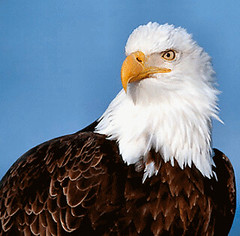 Two celebrity bald eagles, Haliaeetus leucocephalus, in the state of Maine have a new set of triplets, and the fuzzy little chicks are attracting lots of admirers on the Internet. Thousands of viewers are logging on to a live Web cam to catch glimpses of the eaglets as they stick their heads up over the edge of their nest at feeding times (there now are two video feeds available for your viewing pleasure). The sight is just as exciting to seasoned scientists, who have never before enjoyed such an up-close and detailed view of an eagle family. The EagleCam offers a new still photo of the nest every 30 seconds. [Windoze Media Player required]. It can take a lot of patience to see the chicks, which are the size of a person's fist and spend most of their time in the bottom of the nest, huddled under their mother or father. But there is no mistaking them when they periodically pose in front of the camera. There also is an EagleBlog, that is updated once per week by three eagle biologists. GrrlScientist says; They should hire me to update their blog daily! Just think of all the happy schoolchildren there would be throughout the state of Maine if they did that. [Photographer: Fresno Chaffee Zoo, USA]
Two celebrity bald eagles, Haliaeetus leucocephalus, in the state of Maine have a new set of triplets, and the fuzzy little chicks are attracting lots of admirers on the Internet. Thousands of viewers are logging on to a live Web cam to catch glimpses of the eaglets as they stick their heads up over the edge of their nest at feeding times (there now are two video feeds available for your viewing pleasure). The sight is just as exciting to seasoned scientists, who have never before enjoyed such an up-close and detailed view of an eagle family. The EagleCam offers a new still photo of the nest every 30 seconds. [Windoze Media Player required]. It can take a lot of patience to see the chicks, which are the size of a person's fist and spend most of their time in the bottom of the nest, huddled under their mother or father. But there is no mistaking them when they periodically pose in front of the camera. There also is an EagleBlog, that is updated once per week by three eagle biologists. GrrlScientist says; They should hire me to update their blog daily! Just think of all the happy schoolchildren there would be throughout the state of Maine if they did that. [Photographer: Fresno Chaffee Zoo, USA]
Miscellaneous Birds
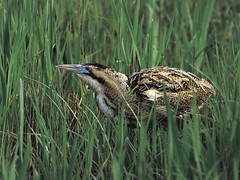 A pair of rare birds have been causing a stir at a west London nature reserve where they appear to have set up home. The two bitterns, usually found in wide expanses of reeds, were spotted at the Kempton Park nature reserve in Sunbury in early February. The bittern, Botaurus stellaris (pictured), is one of the most elusive birds in the British Isles; in 1997 there were only 11 male bitterns left in England. [Photographer: Broads Authority, UK]
A pair of rare birds have been causing a stir at a west London nature reserve where they appear to have set up home. The two bitterns, usually found in wide expanses of reeds, were spotted at the Kempton Park nature reserve in Sunbury in early February. The bittern, Botaurus stellaris (pictured), is one of the most elusive birds in the British Isles; in 1997 there were only 11 male bitterns left in England. [Photographer: Broads Authority, UK]
A flock of one of the world's most endangered birds, the white-shouldered ibis, Pseudibis davisoni, has been discovered in a remote province in northeast Cambodia, a conservationist said Monday. A flock of between 20 and 30 white-shouldered ibis, a critically endangered species with only 250 existing in the wild, was found in a protected wetland in Stung Treng province, said ecological adviser Kong Kimsreng of the Mekong Wetland Biodiversity Conservation and Sustainable Use project. The flock was first found during a survey last November in the province, 150 miles northeast of Phnom Penh. "The main threat to the white-shouldered ibis is chick- and egg-collecting by local people," Kong Kimsreng said. "They don't understand that this is an important bird, that this is a rare bird in the world. They collect the chicks to keep as pets... to make their house nice."
A parrot has spent more-or-less five days under police interrogation in prison in Argentina. Two neighbors, Jorge Machado and R Vega, were fighting over the ownership of the bird so a judge ordered Pepo the parrot to be held in custody until he told police who his real owner was, reports UOL.
The Fine Print: Thanks to my bird pals; Diane, Caren, Dawn, Jeremy, Ellen and Ron for some of the news story links that you are enjoying here. Many thanks to Wally for his kind $upport and to Cath for the yummy Belgian ale. Thanks Ian for catching my error (you know I put one error per BitN just so you can find it, don't you?). All images that appear here are resized and are either linked from the news stories that they accompany or they are linked to the site where they are found. You can follow these links by clicking on individual images. The large "featured image" at the top appears here by permission.
Previous : : Birds in the News : : Next
tags: Birds in the News, ornithology, birds, avian, newsletter


You know that the starling paper is hotly contested, don't you? Chris of Mixing Memory has some thoughts on this, as well as links to all the relevant discussion here and here.
re: the featured bird
Love the PABU! Once I helped at at MAPS banding site in southern Texas where PABUs were by far the most common birds in the mistnets. We got a green jay too.
>>Second Word War
It would be sad to hear that a full blown war was waged over 'Words' ... let alone two! ;-D
Thanks for the updates.
I loved the cantakerous goose story. I can attest with personal experience to the rehabilitating an uplifting effect of being around friendly birds.
Excellent edition. Thanks again.
The Painted Bunting must be the most spectacularly colored bird on the planet. It is really a shame that we won't see these birds here in Washington.
A great round-up of the news. We have been watching the eagle cams, but have found two local eagle nests that we try to get to often. It's pretty exciting to watch them.
thanks everyone, for your comments. even though i don't often respond, i do read and enjoy everything you say because your comments mean that you are reading and enjoying BitN.
i was working on my own comments about the starling paper and got sidetracked by a four day long "wild goose chase" for a particular starling picture that turned out to be an "orphaned" image. i shall try to get my own essay posted soon, though.
well, actually ... there WAS a male painted bunting in Seattle four years ago. i hunted him down several times, and got great looks at it. he was spectacular!
I'm so glad to read that there was a male painted bunting in the pacific northwest. It gives me hope and something to look for. Woohoo. I love seeing a new bird.
I took this Painted Bunting photograph a few months back...it was the first male PABU that I had ever seen, and it was very exciting. Just today I was talking with a colleague at work and he told me about his own bunting experience last week. After noticing some unusual activity at a nearby park he investigated and found a few bird traps with live Indigo and Painted Buntings inside. He turned the case over to the U.S. Fish and Wildlife Service, and they successfully tracked these crooks to a local South Florida pet shop. Yesterday, 45 buntings were released back into the wild so that they could hopefully resume their northward migration. Sadly it seems that this problem is fairly widespread among much of their wintering grounds.
Re the painted bunting: I think it's terrible that people catch buntings and smear paint all over them just to make flashy bird pics. Where's the ASPCA?
I was hoping you would mention the Starling paper - and have some comment - thanks to Coturnix for further info (though the second link is broken).
Maybe you can sort this out for me. When the Ivory-billed Woodpecker story broke it was not the video image of the bird that initially convinced many skeptics that it was alive, but it was the audio recording of its calls that was touted as proof. How come this evidence has disappeared from the discussion about whether or not the bird was found? Was the audio evidence determined to be insufficient?
Bob
Last summer i watched a apir of WESTERN KINGBIRDS chasing a REDTAIL HAWK its incredible to realize how fearless these birds are